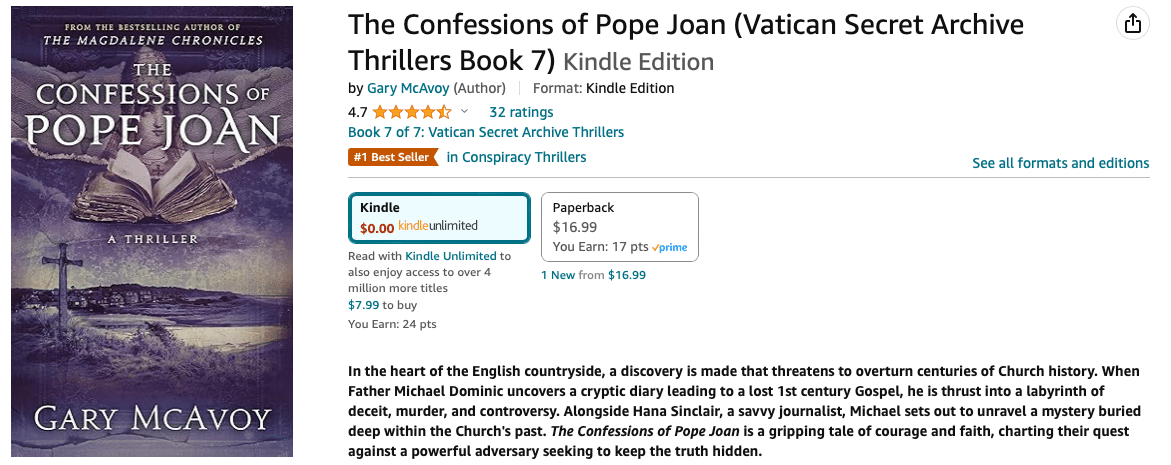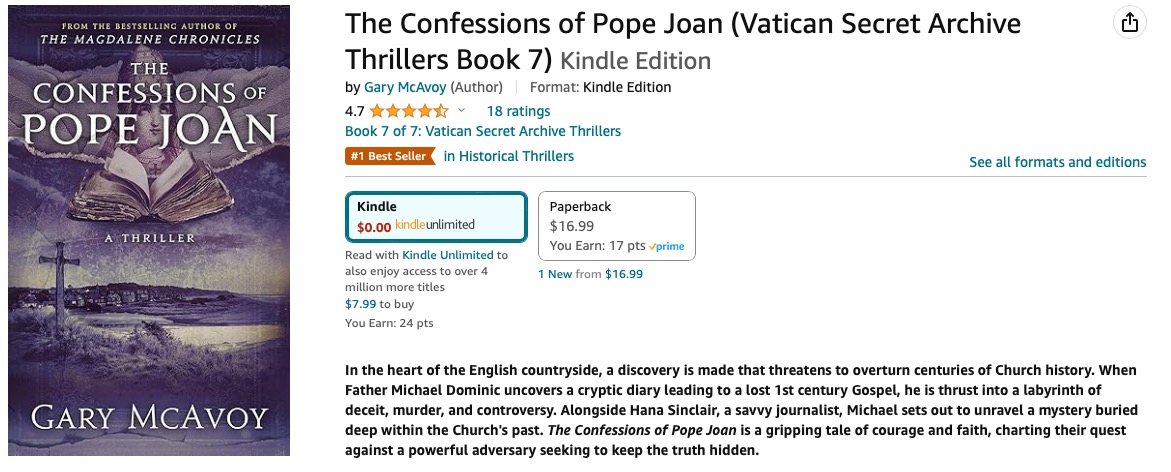Fiction, Fact, or Fusion?
Many readers of my work appreciate distinguishing fact from fiction in my books. Generally, I like to take factual events and historical figures and build on them in creative ways—but much of what I do write is historically accurate. Here, I’ll review some of the chapters in each book where questions may arise, with hopes that it may help those who are wondering.
This is especially useful for earlier audiobook listeners, since this section appears only in printed or digital books.

PROLOGUE: The Cathar fortress on the peak of Montségur, France is an actual historical monument. The entire Languedoc region was central to Pope Innocent III’s Albigensian Crusade and is depicted historically here in nearly exact detail.
Though Abbé Marty was, in fact, an authentic Cathar cleric at Montségur, the activities given him in this book are purely fictional.
CHAPTER 6: The Riserva is an actual room in the Vatican Secret Archives where the Church’s most sensitive documents and artifacts are kept. As there are no known photographs or other descriptions available, I have conceived my own interpretation of what that room might be like for conservation purposes.
CHAPTER 8: Bérenger Saunière was, in fact, the vicar of Rennes-le-Château in the Languedoc region of southern France in the late nineteenth century. Numerous legends surround him and his assistant, Marie Dénarnaud, who also was a real person.
Abbé Saunière did find several scrolls in a Visigothic altar in his church, though for this story I have taken creative liberties with what he found.
CHAPTER 13: Again, descriptions of Bérenger Saunière and Marie Dénarnaud and their activities are all historically accurate.
As for Hitler and the Allied powers’ use of tarot cards and astrologers—also accurate, among the more bizarre historical nuggets I was able to dig up.
Otto Rahn also was a historic figure, as were his expeditions seeking the Holy Grail. His book, Crusade Against the Grail, is real and still in print.
While Nostradamus obviously was a historical figure, the quatrains I proposed here are fictional. Saint Malachy also was real, as was his curious prophecy of the popes.
CHAPTER 17: The Nazis’ SS-Ehrenring, also called the Death’s Head Ring, was an actual symbolic ring personally given out by Heinrich Himmler. There were an estimated 11,000 such rings distributed, each of which had to be returned to Himmler on the death of its wearer.
One of the more enlightening facts for me to have discovered was the Ustasha, a fascist organization—and ultimately de facto government—of the Independent State of Croatia during World War II. In the Balkans, the Ustasha did rival the Nazis for its fearsome treatment of Jews, Serbs and Roma Gypsies in their own concentration camps, in order to enforce a more racially pure Croatia under forced Catholicism. The Vatican did have full diplomatic relations with this heinous group, and participated in the Franciscan ratline for Nazis escaping prosecution.
CHAPTER 19: Wolfram von Eschenbach’s epic poem Parzival was, of course, genuine, and it is believed by many Grail scholars that “Monsalvat” mentioned in the work actually referred to “Montsegur.”
The Last Will & Testament of Bérenger Saunière is, in fact, genuine. I can’t believe I actually found it, as hard as it was to locate.
The French Resistance Maquis fighter known as “Achille” was, in fact, an actual historical figure. Little is known about him, though, so what you find here is purely fictional.
CHAPTER 23: Marie Dénarnaud’s niece, Élise, does not exist (as far as I know, Marie had no family).
CHAPTER 27: While there is a gnostic text called the Gospel of Mary, which scholars do attribute to Mary Magdalene’s life, it should be clear that the manuscript I attribute to her is entirely fictional.
CHAPTER 28: While Cardinal Lucido Parocchi was an actual Church figure in the late 1800s, the papal legate I describe here, Monsignor Franco Moretti, and his letter are of my own imagination.
CHAPTER 29: ECHELON is an authentic surveillance program operated by the United States with the aid of four other signatory states to the UKUSA Security Agreement: Australia, Canada, New Zealand, and the United Kingdom, also known as the Five Eyes. My description of its processes, however, is almost entirely my own creation… but given my technology background, my guess is that I came pretty close.
CHAPTER 31: While there are many who believe Jesus Christ and Mary Magdalene may have been married and may have had children, there is, of course, no evidence of that; consequently, the assertions here (as well as her papyrus) are depicted fictionally.
CHAPTER 35: The safe-cracking tools used by Roko Sirola—including the hotel keycard emulator—are all real products anyone can buy. As for the default codes used in hotel in-room safes, all of that is entirely real. Try it next time you stay in a hotel room.
Since this book was published in early 2020, the world has come to well know Apple’s AirTags. But, when I wrote this, AirTag had not yet been produced or marketed, and it would be another full year before Apple did release them. As a follower of technology news, I knew this product was coming up and took the chance Apple wouldn’t change its name! But since then, a few readers have complained that “Well, everyone knows what AirTags are! Why doesn’t Hana?” To which I say, Yes, now they do, but not when I wrote this. So don’t blame her… blame time.
CHAPTER 37: Operation Jedburgh was a true event, a mission coordinated between U.S. and British intelligence agencies.
The description of Ustasha treasure, including the Mafia’s help in melting gold bullion for deposit in the Vatican Bank, is all factual.
Archbishop of Croatia Aloysius Stepinac also was a real figure and his activities documented here are all authentically recorded.
CHAPTER 40: Sadly, the story about the Nazis demanding fifty kilos of gold from Roman Jews or face dire consequences is true.
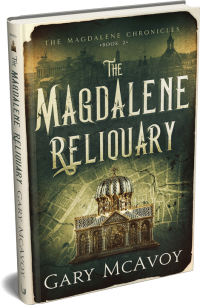
PROLOGUE: All characters featured in the Prologue—Raymond-Roger Trancavel, Viscount of Carcassonne; Raymond VI, Count of Toulouse; Godefroy de Bouillon, conqueror and first ruler of the Kingdom of Jerusalem; Raymond VII, Count of Toulouse; and Pietro Vesconte, the most renowned mapmaker of his time—were all real figures. The sacred reliquary passed among them is a fictional artifact.
The puzzle I describe later is actually the brainchild of a puzzle master living in Greece today.
CHAPTER 1: The mechanics of caving as described here are completely accurate, as generously provided to me by an expert British caver named Martin Hoff. Like Michael Dominic, tight spaces are not my favorite places to be in.
There is, in fact, a legend that the Cathars actually buried their “treasure” in one of the caves of the Languedoc region. There is nothing to distinguish what that treasure might have been.
CHAPTER 3: In Codice Ratio is an actual program of the Vatican’s in which ancient manuscripts are being transcribed into machine-readable text using advanced optical character recognition.
CHAPTER 5: Guillaume de Sonnac, eighteenth Grand Master of the Knights Templar, was a real historical figure, but his journals have been contrived for this story.
CHAPTER 6: Though the original Croatian Ustasha was an actual fascist organization, the “Novi” Ustasha is entirely fictional.
CHAPTER 7: The Vatican’s Secret Archive (or what has recently been renamed the Apostolic Archive) does in fact extend beneath the expanse of the Pigna Courtyard and does possess fifty-three linear miles of shelf space. Most of its vast inventory has never been cataloged, nor has it been seen by anyone living.
CHAPTER 9: As a foodie myself, I love feeding my characters what I think they might enjoy. The meals I use in my stories are all from authentic menus at the real restaurants I mention—in this case, from the Michelin-rated La Pergola in Rome.
CHAPTER 13: The folding plate puzzle used here is, in fact, a real device, used with the generous permission of its ingenious creator, Pantazis the Megistian. Using similar elements of Rubik’s puzzles, it does actually transform from its unusual original shape to one of a square tower.
CHAPTER 24: The simplistic DNA sequencing description I provide here is more or less accurate, although much more is actually involved. But the basics provided are used in actual practice.
CHAPTER 34: The story of Mary Magdalene, her siblings and several disciples, and a young “maid” named Sarah—all cast adrift in an oarless boat on the Mediterranean—is based on actual oral tradition.
CHAPTER 35: The tombaroli or tomb raiders of Rome are an actual group, and their leader is called the capo zona, regional chief. Not surprisingly, Rome has a massive black market trade in antiquities, keeping the also-real Italian Art Squad very busy.
CHAPTER 43: The description of carbon-14 dating is as accurate as I could describe without being overly complex. As longtime readers know, I favor passing along knowledge of things I’ve always wanted to know myself, reducing them to simpler explanations.
CHAPTER 51: The Geneva Free Port is the real deal, filled with the works of art, bottles of wine, and other high-value collectibles exactly as I describe them here. It is also a bane to Customs authorities since sales and purchases can be made on the property, all tax-free, while still retained on-site in the ultra-secure facility.
CHAPTER 54: As I mentioned in the Author’s Note for The Magdalene Deception, Apple’s AirTags are actual products that perform as described in the book. Since this book was published in mid-2020, the world has come to well know Apple’s AirTags. But, when I wrote this, AirTag had not yet been produced or marketed, and it would be another year before Apple did release them. As a follower of technology news, I knew this product was coming up and took the chance Apple wouldn’t change its name! But since then, a few readers have noted that “Well, everyone knows what AirTags are! Why doesn’t Hana?” To which I say, Yes, now they do, but not when I wrote this. So don’t blame her… blame time.
CHAPTER 61: The mechanism for unlocking cars remotely using a relay scanner is a fact, as described.

PROLOGUE: Nazi SS Reichsführer Heinrich Himmler, one of Hitler’s top generals, was indeed obsessed with the occult, and instigated activities which took place in Wewelsburg Castle (a real place, even today as a museum and youth hostel) including supernatural and strange rituals in the Consecration Hall. Himmler did send Otto Rahn on archeological expeditions in the mid-1930s, and Rahn was reputed to eventually have brought “something” back to Himmler from his discoveries in southern France. We don’t know what that was, or even if it happened at all.
The Veil of Veronica is, as far as we know, a true legend, an oral tradition passed down through the centuries. I did take fictional liberties with the veil being passed on from Berenikē to Magdalene.
CHAPTER 1: I did base two characters on actual historical figures, but for prudent legal reasons I was encouraged to change their names in the book. In spite of these changes, the backgrounds and actions of these two people in particular are, for the most part, based on recorded historical events. Their families as portrayed in the book, however, are entirely fictional.
FOR FURTHER RESEARCH, SEE:
https://en.wikipedia.org/wiki/Walter_Rauff
https://en.wikipedia.org/wiki/Erich_Priebke
CHAPTER 4: The Thule Society, the Ahnenerbe, and “The Twelve” were all authentic groups during the Nazi era. The Ahnenerbe’s mission was, in fact, to justify the Holocaust and its brutal extermination of Jews and other “undesirables” in the years leading up to and during the war.
Bishop Alois Hudal was a real-life figure who did oversee the Vatican ratline as a Nazi collaborator. More information on him is available at https://en.wikipedia.org/wiki/Alois_Hudal.
The three-fragment riddle I composed is purely the result of my own imagination.
CHAPTER 6: Bishop Hudal’s book Roman Diaries was indeed published thirteen years after his death. In it you’ll find the actual passage, as quoted in this book, regarding his visit to Allied detention camps, where he felt the Nazis were being mistreated.
The Schwarze Sonne, or Black Sun, mosaic is genuine and can still be found today on the floor of the Generals’ Hall at Wewelsburg Castle in Büren, Germany.
CHAPTER 7: The Vatican’s Riserva is, in fact, the most sensitive Archives room in the Vatican, though I have little idea what it actually looks like—so I’ve had to improvise in describing it.
Himmler’s journal and Hudal’s letter to the pope are both fictional devices.
CHAPTER 8: Heinrich Himmler did keep diaries since he was ten years old, and the latest one to be found had actually been confiscated by the Russian Red Army at the end of the war. The notations about Himmler’s preternatural view of the Jews in concentration camps and the vicious dogs are all true, taken from his own journals.
The biblical passage I quote here, John 20-3:7, is correct as used in the book (notwithstanding my fictional use surrounding it). The Bible’s various editions may vary in terminology.
CHAPTER 9: Simon Ginzberg’s description of the extant veils in the various locations mentioned is accurate and factual, as is the discussion about the name Veronica (vera icon in Latin).
CHAPTER 14: Javier Batista’s mention of Operation Oriente Cercano was an actual event—a police raid in which a horde of Nazi artifacts and memorabilia was discovered hidden in a secret room behind a bookcase in a house in Béccar, Argentina in 2017.
CHAPTER 29: The fascinating image of Christ’s face is actually an existing overlay of the real-life Manoppello veil contrasted over the face on the Shroud of Turin, a discovery made by Sister Blandina Paschalis Schlomer, a German Trappist nun, in which the combined overlaid images were found to be identical.
The usage of the Manoppello and Turin Shroud image, depicted fictionally herein and slightly modified, is licensed under the Creative Commons Attribution-Share Alike 3.0 Unported license. With kind permission by Brother Benno, given August 6, 2006.
CHAPTER 32: The Kinderklinik emerged from my own imagination, though Bariloche is a German settlement in the Patagonia region of Argentina. Nine thousand Nazis emigrated there after the war, and their families still populate the region.
The Lebensborn program was an actual German program initiated by the SS, with the goal of raising the birth rate of Aryan children by those considered “racially pure” and “healthy” based on Nazi racial hygiene and health ideologies.
And the Red Falcons were, in fact, the highly-indoctrinated Nazi equivalent of the Boy Scouts and Girl Scouts, though with different agendas.
CHAPTER 33: The once SECRET, now unclassified CIA document is fully authentic, and widely available on the internet. By sheer coincidence it addresses verbatim the exact situation I needed for the story and fit perfectly.
MISCELLANEOUS NOTES: Descriptions of all actual buildings and roads is accurate, thanks to the marvels of Google Earth and other resources.
Referenced hotels, restaurants (even menus), airlines and flight times are all factual. Accounting for verified and presumed times, including travel, the book took place over a real-time span of forty-one days.

PROLOGUE: Cardinal Pietro Ottoboni was an actual figure in the Church, as described, and a major benefactor of the arts. And yes, he did father between sixty and seventy children among his many mistresses; times were certainly different back then. He did fall ill and die during the papal conclave of 1740, but as far as I know he died of natural causes. I’m the one who poisoned him. I don’t know if he knew Antonio Vivaldi, though it’s highly probable he did.
The devious scoundrel Cardinal Niccolò Coscia was also a real life figure and was heavily penalized for misappropriation of Vatican treasury funds. And yes, there was mystery connected to the extreme reduction in his punishment.
Antonio Vivaldi was, in fact, a Catholic priest, which—having a longtime appreciation for Vivaldi’s work—surprised even me when I discovered it in my research. He spent decades of his life teaching violin to young girls at an orphanage called the Pio Ospedale della Pietà (Devout Hospital of Mercy) in Venice, Italy.
CHAPTER 1: The proliferation of pigeons—and the serious destruction they cause to buildings in Piazza San Marco—has been described accurately. They have become a real menace, and tourists are discouraged from feeding them since their nesting in the buildings, as well as waiting for food, does incalculable damage to the ancient structures.
Venice’s Biblioteca Marciana (the Library of Saint Mark) does have the oldest actual texts of Homer’s Iliad, and the only autograph (meaning handwritten by the author) commentary of Homer’s companion work, Odyssey, from the twelfth century. All descriptions of these works are accurate.
CHAPTERS 2 AND 8: The images of the Vivaldi documents are not authentic and were digitally prepared for this book by me and my music collaborator Dr. David Loberg Code, Associate Director of the School of Music and Professor of Music Theory and Technology at Western Michigan University. However, as a manuscripts collector myself, I have come across such authentic material, and it does have a similar appearance. I prepared the images using antiquing software, though couldn’t achieve a more handwritten effect like I’d hoped.
CHAPTER 3: I’ve spent a great deal of time in Venice and, like Michael Dominic, count it as my favorite city in the world. (If only the cruise ships would leave, it would be a much better place.) The magnificent palazzos on the Grand Canal feature prominently here, and my descriptions of them are as I recall and as I have photographed them.
The Camorra, as many readers may know, is an actual Mafia organization in various regions throughout Italy. It has a flatter organizational structure but the same criminal enterprises as other Mafia clans. I doubt they have much influence in La Serenissima—since Venice has its own Mala del Brenta organized crime group—but the Camorra’s presence elsewhere and its long history did come in handy for the story. My descriptions of the Camorra clan here are largely fictional, though.
CHAPTER 6: I count myself fortunate to have come across Dr. David Loberg Code and his ingenious Solfa Cipher (see Acknowledgments), which served as the initial inspiration for this book. I’ve loved codes, ciphers, and cryptology in general since that was part of my job in the U.S. Army decades ago, and bringing Vivaldi into the world of secret codes made perfect sense and a good foundation for this work.
CHAPTER 7: Palazzo Grimaldi and its story is completely fictitious. Other than the fact that the House of Grimaldi is over eight hundred years old and does have an illustrious history, I know nothing of the family’s estate holdings throughout history, nor whether or not they ever had a palazzo in Venice.
Giulia Lama was a real and outstanding female painter in the all-male world of artists in eighteenth-century Venice, and she struggled to maintain her notability despite men taking credit for—no, actually stealing—her work.
CHAPTER 8: Count Giacomo Durazzo was, in fact, the owner of the Vivaldi manuscripts—some three hundred concertos and twenty operas—in the late 1700s, purchased from a Venetian senator named Count Jacopo Soranzo, who acquired them from Vivaldi’s brother Francesco after Antonio died in 1741. Two brothers from the Durazzo family inherited the manuscripts in the late nineteenth century, and eventually they were sold off to library museums.
CHAPTER 10: Harry’s Bar is among the most beloved landmarks of Venice, having been the hangout for Ernest Hemingway and others mentioned in the book, along with so many more celebrities as well as folks like you and me. As longtime readers know, the foods I write about all come from actual menus from real restaurants mentioned, many of which I’ve actually dined at over the years. Ah, if only Venice were closer to Seattle….
CHAPTER 11: Yes, the Vatican does indeed have 70,000 works of priceless art in its inventory, 50,000 of which are tucked away in storage most of the time. Seems a shame, really, that so few people will ever get to see them.
The artworks I describe are all authentic pieces by the artists mentioned; none of that is fictional, apart from the forgeries I invented.
CHAPTER 12: Carnivale is Venice’s annual, months-long gala celebration similar to New Orleans’ Mardi Gras. Costumes are a big and very serious part of it, and the long history I described about them is spot on. Antonia Sauter’s famed atelier is the place to buy couture costumes, as is Ca’ Macana for the most exquisite genuine historical masks Venice has to offer. I’m almost one hundred percent sure the Swiss Guard would never be permitted to wear their official gala uniforms at a costume party; but hey, it’s my book.
CHAPTER 18: The processes for establishing authenticity of a painting are all depicted accurately here. There are many more, of course, but in the interests of time and prevention of boredom, I omitted the others.
CHAPTER 20: The Vatican very probably has its own internal restorations team and would likely never send paintings out for such work. But using an old established firm in Venice was crucial to the plot; hence, the use of the fictional Palazzo Feudatario.
CHAPTER 27: Shockingly, it is true that, day and night, twelve cars are stolen every hour in Italy! And the Fiat Panda is the most popular for thieves. Having rented one on a particular trip from Milan to Lake Como, I can’t imagine why.
The process described here for aging canvasses to antique them is accurate, and a favored method used by forgers (“old cigarette butts soaked in rainwater?!” Yep.)
CHAPTER 28: I am not a runner, but for those who are, this course through Venice is, I am told, one of the best for taking on the city’s interior. If you ever get there and need some exercise, give it a try.
CHAPTER 31: Just a little sidebar here. In laying out Marco’s scheme for getting the drop on the bad guys from a bridge, with Hana driving the boat below him, I actually used a detailed canal map of Burano island to do this. Imagine my surprise, then, to find that the specific yet random bridge I chose—the only one that would work for the scene—actually did cross a canal called the Rio Assassini—the River of Assassins! Coincidence?
CHAPTER 34: The processes described here are the actual methods used by forgers for creating their faux masterpieces. Today’s fakebusters are scrupulous in analyzing pigments as described. Thomas Hoving, former director of New York’s Metropolitan Museum of Art, once wrote that he believed nearly half of all art he had evaluated for museums in his long career was fake. So, caveat emptor.
CHAPTER 39: Italian trains have two classes of car: First Class and Second Class. The difference in cost is minor, only a few euros, but First Class seating is more spacious, with fewer seats per compartment, and usually quieter. There is more room for luggage and it will generally be less crowded, since most passengers typically travel in Second Class. Just FYI if you’re ever considering between the two.
Like the Vatican, the Uffizi Gallery in Florence most likely does their own restorations in-house, not sending them to a fictional palazzo in Venice.
CHAPTER 41: Just so you know, twenty-five million euros for a Raphael is certainly within the range such paintings go for. There are only 184 known Raphaels extant today, but as one of the most prominent and distinguished artists of all time, his work is in great demand (by the few who can afford it).
CHAPTER 42: When I first introduced Apple’s AirTag tracking discs in The Magdalene Deception—long before they would be officially released, and based only on tech rumors at the time—I was holding my breath that the company would not fail me, or worse, change the name. Thankfully, AirTags were released in mid-2021 (I wrote that book in late 2019), and they worked as well for saving Hana in this book too.
EPILOGUE: The prestigious Vatican medals and awards described here are actually used by the pope for valued services rendered to the Church.
GENERAL NOTES: I’ve really come to enjoy Marco Picard and his involvement with Hana. Having introduced him in The Magdalene Veil, I didn’t realize he would become so prominent in future stories, but I do like the way Dominic struggles with his feelings for Hana, and the challenges his calling has burdened him with. However, some early reader feedback tells me they feel bad for Michael and are upset with Marco having taken Hana. To which I say, stay tuned…
All firearms mentioned in the book are as described. Glocks are made of a highly durable plastic, favored for their lightness by police departments worldwide. The Swiss Guard uses SIG Sauers as their primary weapons of choice, though they have a wider assortment based on the demands of each operation.
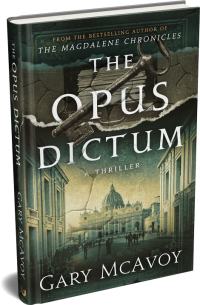
GENERAL: With one or two minor exceptions, all descriptions of the Vatican—its buildings, special rooms, offices, and furniture—are as accurate as I can find, having relied on an abundance of maps, floor plans, diagrams, books, and articles which I have collected for years. I want readers to actually “be there” as they travel through the story.
The same goes for trains and planes (and their actual schedules, flight numbers and travel times), restaurants, trattorias and caffè shops (and their menus). Among the countless emails and reviews I get from readers, a great many of them appreciate descriptions of the food our characters eat wherever they go. There are a lot of foodie fans out there.
PROLOGUE: The story of Roberto Calvi, his shady dealings with the Vatican Bank and Banco Ambrosiano, as well as his death, are all true. The events surrounding his death as I have described them are factually corroborated, including his missing briefcase—which served as the inspiration for this story. Though when it was found, it did contain incriminating papers and a forged passport, I added the safe deposit box key as an extra touch, which served the story well.
Propaganda Due (pronounced Doo-ay, the number two in Italian), or P2, was a real Masonic lodge, banned by Italian law in its later existence. It is believed now to be defunct (but who really knows…?). Many priests, bishops, and cardinals were known to have been members—an affiliation punishable by excommunication—though there are no known cases of such. The descriptions in the book of P2 and its adherents are all authentic. Apart from a few fictional additions, everything else in the Prologue is true.
CHAPTER 1: The Vatican switchboard and computer networks, as described, are managed and operated by, respectively, the Sisters of the Pious Disciples of the Divine Master and the Daughters of St. Paul, or Pauline nuns, who are also known as the “Media Nuns.”
CHAPTER 5: Though there are some structural similarities to the actual personal prelature known as Opus Dei, my “Opus Deus” is a completely fictional entity and has no bearing whatsoever on the interests or activities of the prelature known as Opus Dei.
CHAPTER 11: Regina Coeli prison and its history are accurately portrayed here. Even today, as with most prisons worldwide, overcrowding is a major issue, and for a truly ancient prison in continuous operation whose roots go back nearly four hundred years, conditions must be as deplorable as I’ve described them.
CHAPTER 12: As far as I know, the pope’s helicopter is not named Shepherd Two—but when he flies on a specially equipped jet leased from Alitalia, the aircraft is known as Shepherd One. I just took it one logical step forward with the helicopter.
The Swiss Guard do in fact play soccer (“football” or calcio in Italian) on the grounds of the Campo Pio XI football stadium not far from the Vatican. Teams comprise both Swiss Guards and Vatican Museum guards, in a sort of fraternal competition. And yes, the pope (at the present time, Francis) does stop by for the occasional game he loves so much.
CHAPTER 16: TSN Roma in Italian is Tiro a Segno Nazionale, translated as National Target Shooting range, hence the abbreviation in Italian, TSN. Early readers of this book thought I had the initials confused, so I point that out here for clarity.
The expert descriptions of weaponry here were provided by a devoted reader of my books who has become a good friend, Ron Moore, a guy with a rich background in this and many other areas of expertise.
CHAPTER 21: I found the legend here of St. Helena quaint, of her having brought an ox cart of earth from Golgotha—the place where Christ was crucified—to seed the grounds of the Vatican gardens, and I couldn’t think of not using it.
Again, my thanks go to Ron Moore for his brilliant introduction to me of the micro scribe punch for imprinting infinitesimally small characters onto most anything. It served good use here for imprinting the gold bars.
CHAPTER 22: References to the Vatican’s financial statement shown here were actually taken from the Vatican Bank’s (IOR’s) publicly released financial statement for 2020.
The Obolo, better known as Peter’s Pence, is in fact the pope’s personal fund to disperse as he pleases, traditionally toward humanitarian initiatives and social promotion projects, as well as to the support of the Holy See. On one day each year, Catholic churches worldwide take up a special collection for Peter’s Pence, which goes directly to the pope.
CHAPTER 23: Villa Rosso is the fictional home of former P2 Grandmaster Licio Gelli. Its actual name was Villa Wanda, named after his wife, Wanda Vannacci. Since 2013, as of this writing, the villa has been under preventive seizure due to an inquiry relating to the evasion of €17 million in taxes for which Gelli and his family are being investigated. The rest of Gelli’s and P2’s history here, as well as Operation Paperclip, are all true and in the public record—including the gold found in the geraniums!—though Silvio Pollastri is fictional.
CHAPTER 26: From what I have been told by Vatican insiders, the pope does actually have a hidden button under his desk to summon his aides, presumably (in my writer’s mind, anyway) to bring an end to a given meeting, or more likely to summon an aide.
CHAPTER 44: The protocols described here in preparing for a papal conclave are all accurate. The entire Vatican goes into a virtual lockdown mode, and secrecy reigns.
In early drafts, I had Cardinal Petrini as one of the cardinal electors—then realized that, in prior books, I had him serving during World War II, which of course puts him well over the age of eighty, thus excluding him from voting in a conclave. Ah, the challenges of being a series writer…
CHAPTER 46: Again, the conclave procedures described here are fairly accurate, but take much more time than I had allowed (for the sake of expediency).
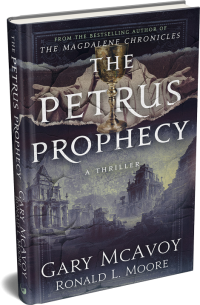
GENERAL: As in all my books, vehicles, trains, airports, transportation schedules, restaurants (and their menus), locations, time zones, and travel times are all consistent with reality. As much as possible, events take place in real time, using actual locations and mentioning local buildings and businesses where suitable. Avid readers have often commented that they have come across specific places I describe in their travels, making their experience that much more realistic and enjoyable.
PROLOGUE: The Milagre do Sol, the Miracle of the Sun, was an actual spectacle seen by as many as a hundred thousand people in Fátima, Portugal, on October 13, 1917, as reported on by newspapers worldwide. According to the legend, Our Lady of the Holy Rosary of Fátima predicted this would occur.
The three shepherd children—Lúcia Santos and her young cousins, Francisco and Jacinta Marto—are on the path to canonization (sainthood) by the Catholic Church as a result of their visions.
And as I describe, the pope is the only person permitted to read the Third Secret of Fátima. It is his decision alone as to whether to reveal it or not. But it must contain something of such terrible magnitude that popes for decades have refused to divulge its true nature. As further described, Pope John Paul XXIII was indeed reported to have fainted upon reading it in 1960, and each succeeding pope has declined to reveal it—except for the allegedly controversial action of Pope John Paul II in announcing what most believe was a different (if not contrived) version of the prophecy. Time will tell as to what the true prophecy holds, if it is ever revealed.
Sister Lúcia’s response to questions about the Third Secret were made up for the story, though in real life she was still circumspect as to the full nature of the prophecy up to the day she died.
CHAPTER 2: Coimbra University in Portugal is one of the oldest continuously operating universities in the world, established in 1290. I chose it for its rich history and geographic relationship to Fátima. Its famed Biblioteca Joanina is well known and highly respected for its superb collection and is considered one of the most beautiful libraries in the world.
FUN FACT: The Joanina Library is noted as being one of two in the world (the Portuguese Mafra Palace Library being the other) whose books are protected from insects by a colony of bats living inside the library. During the night, the bats consume the insects that appear, eliminating the pests. Each night, workers cover the stacks with sheets of leather. In the morning the library is cleaned of bat guano.
The Knights of Malta are, of course, a widely recognized Catholic order founded in Jerusalem in 1099. The order is officially known as the Sovereign Military Hospitaller Order of Saint John of Jerusalem, of Rhodes and of Malta. All facts as described are true as of this writing.
CHAPTER 3: The Knights of the Apocalypse were once an actual secret society created in Italy in 1693 to defend the Catholic Church against the expected Antichrist. Though long disbanded, I have used the name of this original order (dubbed KOTA) as a fictional entity, but there are apparently many such named groups operating on social media sites as of this writing, which claim to be carrying on the appeal and goals of the original organization. This book has no relationship to any of them.
As used, both the Prophecy of St. Malachy and the Apocalypse of St. Peter are legitimate historical references. I leave it to readers to explore more on those topics as desired.
That Enrico Petrini’s surname actually translates as a derivative of “Peter”—as in “Petrus Romanus” in St. Malachy’s prophecy—was absolute providence. I couldn’t believe my good luck, or unwitting prescience, if you can call it that, in originally naming that character years ago.
CHAPTER 5: Villa Stritch, the housing complex for American priests in Rome, is an actual residential compound, owned by the U.S. Conference of Catholic Bishops. Using photographs and other resources, I have described it as accurately as possible.
CHAPTER 6: Domus Santa Marta is the Vatican’s residential guest house, just southeast of St. Peter’s Basilica. The building functions as a guest house for clergy having business with the Vatican, and as the temporary residence of members of the College of Cardinals while participating in a papal conclave to elect a new pope. I have used it as Michael Dominic’s permanent apartment—which isn’t a stretch, since as of this writing Pope Francis currently uses it as his apartment, forgoing the more opulent suite of rooms in the Apostolic Palace reserved for each pope.
The noted vicious rivalry between Italian football teams Roma and Lazio is real and is among the most anticipated games of the year for Italian football (soccer) fans.
Following is a summary of the three prophecies as used in the book. Two of them—St. Malachy’s and St. Peter’s—are historically factual. Apart from living popes, no one yet knows what the true Third Secret of Fátima contains, so the third element has been contrived for use in the book and should be considered fictional:
— The Prophecy of St. Malachy: stating, among other things, that the last pope would be named Petrus Romanus, or Peter the Roman.
— The Apocalypse of St. Peter: a vision of heaven and hell, describing the punishments for various types of sins.
— The Three Secrets of Fátima (the first two of which have been revealed):
(1) A horrific vision of hell as described by Our Lady of Fátima;
(2) World War I would end, and another Great War would erupt under the reign of Pope Pius XI;
(3) Our fictional Third Secret of Fátima:
(a) The rogue planet of Nibiru (Wormwood) is on approach to Earth and would fulfill the prophecy as described in Chapter 8 of the Book of Revelation;
(b) The pope would publicly denounce the Third Secret and would be struck down;
(c) The pope who revealed the Third Secret would be the last pope, would betray his flock, and the End Times would arrive.
In 1960, the Vatican issued a press release stating that it was “most probable the Secret would remain, forever, under absolute seal.”
CHAPTER 8: The “Petri Crypta” (the Vault of Peter) is an entirely fictional device. I tend to doubt that the pope would have a personal safe in his office—but who knows?
All biblical references throughout the book are legitimate and worked nicely into the plot.
CHAPTER 12: Papal coats of arms, or armorials, are the personal coats of arms for popes of the Catholic Church, a tradition since the late Middle Ages. Each pope has displayed his own as related to his family history, and in some cases are composed by the pope himself with symbols referring to his past or future aspirations. A pope’s personal coat of arms coexists with that of the Holy See, always bearing the Keys of St. Peter and the papal tiara, along with a personal motto. Ron Moore actually devised the coat of arms for Pope Ignatius using symbology fitting the nefarious plot of this book. Don’t be surprised if Pope Ignatius chooses a different one soon….
CHAPTER 13: Obviously, since the Petri Crypta is fictional, there are no backup keys, and the Clavis Domini, or Key Master, is not a real person.
CHAPTER 15: Each pope does have an actual Sacra Consulta—a body of trusted advisors initially set up as a special commission by Pope Paul IV in 1559—upon which popes draw advice on matters related to the Church.
CHAPTERS 18 and 29: Rosslyn Chapel in Roslin, Scotland is an actual historical edifice with a rich background. It is, in fact (and in another example of unwitting prescience?) owned by the Saint-Clair family of Scotland. It is one of the region’s most touristed locations.
Sharp readers of my past books will recognize the questions asked of Father Dominic on his quest to obtain the keys, something only found in consultations with the old scholar Simon Ginzberg, from whom the keepers of the keys obtained the questions.
CHAPTER 19: Being a puzzle fan myself, I love introducing puzzles into my books, and in concert with Ron, we thought this archaic keystone substitution cipher was a good one to be found at Rosslyn Chapel.
CHAPTERS 20-21: Forgive our tortured attempts at the Scottish brogue, clearly influenced by Jamie Fraser of Clan MacKenzie in the famed Outlander series. (Ah dinnae ken, for example, means “I don’t know.”) Go figure.
Private jets, it turns out, fly much higher than commercial aircraft. Commercial jets fly between 31,000 to 38,000 feet, whereas private aircraft fly at 41,000 to 48,000 feet, allowing for more direct routes away from the most congested areas of the sky.
The Vatican does indeed dabble in astronomy and has for over two hundred fifty years. Its main telescopes are located at Castel Gandolfo, the pope’s summer retreat in the Alban Hills outside Rome. But it also has a prominent observatory, as described in the book, in Arizona at the Mount Graham International Observatory.
The nickname LUCIFER, however, was largely contrived on the internet many years ago such that it became the stuff of legend. At its inception it was called the Large Binocular Telescope Near-infrared Spectroscopic Utility with Camera and Integral Field Unit for Extragalactic Research (hence, L.U.C.I.F.E.R.). But to clarify things—and avoid the obvious unfortunate moniker—the Vatican later named its own unit the Vatican Advanced Technology Telescope (VATT).
Planet X, also referred to as Nibiru and Wormwood, are also real references to the alleged existence of a rogue planet somewhere out there. Two CalTech researchers, Konstantin Batygin and Michael E. Brown, did in fact publish theoretical findings of their discovery of the planet in the Astronomical Journal in 2016. Readers interested in further knowledge of this topic are referred here.
CHAPTER 27: It’s true: over the years, Maltese hunters have eviscerated the island’s seagull population, the first time I’d ever heard of such a thing. They do have a colony of rare, protected yelkouan shearwater seabirds common to Malta, though; a small seabird widespread in the Atlantic, Pacific, and Indian oceans, mostly in tropical waters.
CHAPTER 28: If you were to visit Malta, every street, location, building and business establishment is located exactly as and where described. So have fun, those of you lucky enough to visit that beautiful island.
Coors Brewing Company’s Keystone beer was another ah-ha! moment for us, as it fit perfectly into the puzzle to find the keys, since everything was related to keystones—those central topmost stones keeping an archway held together at its apex.
CHAPTER 33: NASA’s “DART’ Mission (Double Asteroid Redirection Test) is authentic and fascinating. As per NASA’s own website:
The Double Asteroid Redirection Test (DART) mission is directed by NASA to the Johns Hopkins Applied Physics Laboratory (APL) with support from several NASA centers: the Jet Propulsion Laboratory (JPL), Goddard Space Flight Center (GSFC), Johnson Space Center (JSC), Glenn Research Center (GRC), and Langley Research Center (LaRC).
DART is a planetary defense-driven test of technologies for preventing an impact of Earth by a hazardous asteroid. DART will be the first demonstration of the kinetic impactor technique to change the motion of an asteroid in space. The DART mission is led by APL and managed under NASA’s Solar System Exploration Program at Marshall Space Flight Center for NASA’s Planetary Defense Coordination Office and the Science Mission Directorate’s Planetary Science Division at NASA Headquarters in Washington, D.C.
DART is a spacecraft designed to impact an asteroid as a test of technology. DART’s target asteroid is NOT a threat to Earth. This asteroid system is a perfect testing ground to see if intentionally crashing a spacecraft into an asteroid is an effective way to change its course, should an Earth-threatening asteroid be discovered in the future.
As for NASA consulting theologians in regard to a planetary impact, in 2015 NASA apparently provided a $1.1 million grant to the Center of Theological Inquiry geared toward a program to study the social impact of finding life beyond Earth. The organization’s press release called it funding to “convene an interdisciplinary inquiry into the societal implications of the search for life in the universe.”
CHAPTER 37: The specialized scanning technology that allows the reading and interpretation of an ancient rolled up scroll is actually being used today. It is unknown if the Vatican is using this process now, but it would certainly make sense that they would adopt it at some point. Be watching for this technology in our next book…
CHAPTER 38: Not restricted to The Avengers or James Bond’s 007, cane guns are real weapons, though the one devised in this book was developed specifically for fictional use.
CHAPTER 41: As used here, Botox has no relationship to cosmetic dermatology. Botox is derived from botulinum toxin, a neurotoxic protein that causes botulism, one of the deadliest known toxins. If Botox were to be drunk, as was KOTA’s plan, it would cause sufficient paralysis for a quick and painful death.
EPILOGUE: By sheer coincidence, Pope Francis had just visited Malta in April 2022, when this book was published. We wish him always safe travels and fair winds.
As for Father Dominic and Hana’s relationship—one of the most common questions I get from readers—honestly, I have no idea what they will be up to in coming books. Reader feedback has been split in both obvious directions, but my inclination is to have Michael stay true to his vows, as I probably would in his position.
But, as most writers will confess, the characters themselves often choose the direction of their own paths in each story. Will Michael leave the priesthood to explore his relationship with Hana? Would she respect him if he did? Will he stay true to the vows he took in his sacred profession? And where’s Marco in all this? Or will there be someone else?
Only time will tell. Keep reading….

GENERAL: As in all my books, vehicles, trains, airports, transportation schedules, restaurants (and their menus), locations, time zones and travel times are all consistent with reality. As reasonably as possible, events take place in real time, using actual locations and mentioning local buildings and businesses where suitable. All cities and streets, landmarks, buildings and their respective interiors and exteriors, wherever located, are described as accurately as our research confirms. Avid readers often comment that in their travels they have come across specific places described here, making their reading experience that much more realistic and enjoyable.
European time is normally spoken in military time units. For example, in the U.S. we would say three o’clock or three p.m. But in Europe (and elsewhere) it would be referred to as fifteen hours (or 15:00): three hours past noon. In light of the vast majority of readers being in the U.S., I have for the most part used the more commonly understood expression of time here, except in descriptions of military-type maneuvers, and ask the indulgence of my European friends and other readers around the world.
The attentive reader will have noticed this is the first book where I’ve begun using “Michael” instead of “Dominic” when referring to the main character. I did so by popular reader demand—since I do listen to reader feedback.
PROLOGUE: The entire first scene is completely factual. King Philip IV was quite the shrewd monarch and exerted firm control over the papacy during his long reign.
Though Pope Clement V did die from lupus, and he did have a brother named Florian de Got, the scene depicted here is fictitious.
In a mix of both fact and fiction, Jerome Baudette is an imaginary figure, but the English ship, Shoreham, was indeed real—though it didn’t sink in the Celtic Sea but in Widemouth Bay, North Cornwall.
The deaths and details of Pope Clement, King Philip and his sons are all accurate, including the crown passing to the House of Valois—which is purely coincidental in relation to my longtime character Pierre Valois, the president of France—but fits perfectly into the story. Serendipity, prescience or divine intervention? Make of that what you will.
As it happens, excavators refurbishing Notre-Dame de Paris Cathedral in 2022 did, in fact, discover a previously unknown fourteenth-century lead sarcophagus, as described here. And they also found another pit beneath that—but the “discovery” of another coffin, along with the parchment scrolls, was solely derived from our imagination.
CHAPTER 4: King Louis XIV, the renowned Sun King, did, in fact, star in scores of ballets while serving as France’s monarch, and expanded on his country’s long-lasting cultural legacy consequent to his support for the arts.
As Lauren Valois describes, that lower pit was indeed discovered in 2022 while building a thirty-meter-high scaffolding to reconstruct the great spire that was destroyed in the 2019 fire. Excavators also did find a fourteenth-century lead sarcophagus, and a lower pit beneath the floor of the cathedral, all as described. The crypt for Jerome Baudette was added fictionally as part of the story.
CHAPTER 5: The description of the reconstruction of Notre-Dame has been reworked from numerous original sources but remains accurate as it appears. Completion of the project is expected to be in 2025.
Though why this odd custom existed is a mystery, boxwood leaves were actually used in caskets to preserve the heads of deceased religious figures and the social elite in the Middle Ages.
All popes do, in fact, bestow engraved rings on the cardinals they elevate, symbolizing their renewed vows of fidelity to the Church, a tradition that goes back to at least Pope Innocent III.
CHAPTER 10: While the Vatican does have an extensive array of many unique laboratories for the restoration of paper, wood, stone, metals, ceramics, paintings, mosaics, tapestries and textiles, the “Authentication and Restoration Laboratory” used here is an imaginative amalgam of all those, and then some. Whether the Secret Archives actually has or uses tomographic X-rays is unknown, but the Franciscan Missionary Sisters of Mary do, in fact, manage the Tapestries and Textiles Restoration Laboratory.
CHAPTER 13: VADNA, or the Vatican Ancient DNA project, is fictional.
CHAPTER 14: The description of Rome’s Sapienza University and its history of illustrious alumni is accurate, and they do have a Genetics and Molecular Biology lab, though its internal descriptions are imagined.
Although the extended discussion of DNA and its processes are all authentic, the VADNA operation and work on the DNA of saints is not (at least to the best of my knowledge).
CHAPTER 17: The sarcophagus of Pope Clement V, as shown in the photograph, is, of course, authentic, as are the descriptions surrounding it in the church of Collégiale Notre-Dame d’Uzeste, or Our Lady of Uzeste, France.
CHAPTER 18: Pastoralis praeeminentiae was the papal bull that authorized the arrest of all Knights Templar and the seizure of their property.
CHAPTER 20: While Philip IV had no fourth son named Robert, nor grandsons named Henri and Hugh, the reigns and genealogy of his other sons occurred as described.
CHAPTER 24: The Palais des Papes, or Palace of the Popes, is the actual castle where the Avignon papacy held residence for sixty-seven years and is largely as described, except for certain fictional elements. The blue doors in the cliffs below the garden are actually there.
CHAPTER 30: Microtomography as described here is a brilliant and fairly recent technology used for reading rolled-up scrolls and other such “inaccessible” material, something the Vatican most certainly employs in its archival processes.
Guillaume de Baufet actually was a notable bishop in Paris in 1314.
CHAPTER 31: The French Sixth Light Armoured Brigade is headquartered at Nîmes and is equipped with the VBCI armored personnel carriers as described.
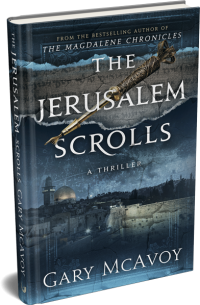
As in all my books, vehicles, trains, airports, transportation schedules, restaurants (and their menus), locations, time zones and travel times are all consistent with reality. As much as possible, events take place in real time, using actual locations and mentioning local buildings and businesses where suitable. Avid readers have often commented that they have come across specific places I describe in their travels, making their experience that much more realistic and enjoyable.
PROLOGUE: Every word in the Prologue is historically accurate and verifiable. The constant plundering of caves is an ongoing problem for the Israel Antiquities Authority (IAA), whose role in preserving biblical history through archeology and working proactively to prevent looting is highly commendable.
CHAPTER 2: There are indeed only sixty-five licensed antiquities dealers in all of Israel, and each ancient manuscript discovered for permissible sale on the open market must be registered with the IAA. As I mention in the book, this is one reason for the proliferating black market and its often-underhanded dealings.
CHAPTER 3: The process of cutting the silver scroll here has actually been done before, on the very Khirbet Qumran copper scroll as described in this chapter. This was done in 1956, since the scroll was too rigidly rolled up to be able to read and translate. After six years of trying to figure out how to do it, scientists ultimately chose a special circular saw and a dentist’s drill to cut the scroll into 23 panels, which are now displayed at the Jordan Museum in Amman.
The 23 Copper Scroll panels at the Jordan Museum in Amman
CHAPTER 7: It is stunningly true that, as of this writing, there are still some thirty thousand caves in the Judean Desert yet to be explored and excavated for what the Essenes and other early cultures may have left behind. Think about that.
Everything about the Mithraists here is historically accurate—except their existence today, which is fictional. From the first through the fourth centuries, when it was disbanded, Mithraism was truly the main rival to Christianity, given the proliferation and influence of the Roman soldiers who made up its membership.
CHAPTER 8: The ancient mithraeum temple constructed deep beneath the ruins of the Circus Maximus in Rome is still intact, and available to visit on tours.
The actual handshake greeting of the syndexioi—members of a mithraeum—are sadly lost in time, so I have contrived what might be a suitable alternative to a secret handshake, based loosely on the similar Freemason’s greeting.
CHAPTER 9: The descriptions of the locations of gold and silver are accurately paraphrased from the Khirbet Qumran Copper Scroll, and represent actual places where the Essenes (not the Mithraists, as used in the story) are said to have buried their treasure. And yes, the estimated value as described in the Qumran Copper Scroll is upwards of $3 billion. Treasure hunters have been searching for the bounty for decades; as far as is known publicly, nothing has yet been found.
CHAPTER 10: Though our silver scroll for the story is fictional, there is factual basis for its existence. The Khirbet Qumran Copper Scroll is an authentic find, part of the Dead Sea Scrolls discovered in 1947. In that scroll, reference is made to a separate silver scroll, which—in addition to having the same descriptions on where the great treasure of the Essenes had been hidden—reveals that the silver scroll expands on those details, providing further clues as to the treasure’s location. To date, that silver scroll has yet to be discovered.
Simon’s description of the value of that copper scroll’s treasure, $3 billion, is based on today’s scholarly estimates.
CHAPTER 11: The IntactPhone is an authentic device developed by an Israeli firm, CommuniTake Technologies. It is the most advanced cellular phone of its kind, and the Israeli government must indeed approve every purchase to prevent it from being used by hostile forces.
CHAPTER 12: Catalogued as Nahal Hever Cave 8 in Israel’s Judean Desert, the nickname “Cave of Horror” was given after the skeletons of forty men, women and children were discovered inside, all Jewish refugees from the Bar Kokhba revolt of c132–136 CE.
Just a small observation here, but I found it curious that in Israel people do eat green salads for breakfast. So keeping with his character, I figured I’d make Pastor Darwin a little vexed by the uncommon custom.
CHAPTER 14: The sixth-century Madaba Map in the Church of Saint George is, as shown, fully authentic, and is still to this day brilliantly resonant with images depicting Jerusalem prior to its destruction in 70 CE. The notes about the map confirming the locations of the Cardo Maximus—the main North-South royal road in Roman and Byzantine Jerusalem—and the Nea Church, as well as another road running through the city, are historically correct.
CHAPTER 17–18: Although Roman Emperor Commodus was believed to have been a strong supporter and a likely member of Mithraism in the second century, I have constructed the mithraeum beneath Jerusalem’s Western Wall in my imagination. I assume there is not one located there—but one never knows…
And there actually is a long network of underground tunnels and cisterns beneath Jerusalem’s Western Wall, still in use today.
CHAPTER 24: The “Jesus Family Tomb” in the East Talpiot neighborhood of Jerusalem is indeed a genuine tomb, long believed by many authorities—notably Dr. James Tabor, a Biblical scholar and professor at the University of North Carolina at Charlotte—to contain the ossuaries of Jesus and his family, attributable mainly to the unique epigraphs inscribed on each bone box. And collectively this is quite compelling, since they identify what is very possibly the family of Jesus Christ. Much has been written on this controversial matter, and the interested reader is encouraged to explore more on the topic.
The parchment “confirming” the fact is, of course, from the author’s imagination. However, those Hebrew names identified in this chapter are the actual inscriptions that appear on each ossuary.
CHAPTER 35: The conditions described for Scorpion Prison in Cairo are as authentic as my research can confirm, including the statement by its former warden (Major General Ibrahim Abd al-Ghaffar) which was accurately quoting him as saying, “It was designed so that those who go in don’t come out again, unless dead.”
There is a moment in this chapter where Hana is shown to have unusually intimate access to the pope. For new readers questioning this, I refer you to previous books rather than give out any spoilers as to why Michael’s predicament would be of interest to the pope. If this is the first book of mine you’ve read and you wish to read more, please start with The Magdalene Deception and go on from there, where things will be made clearer.
CHAPTER 38: It gave me no pleasure to describe the torturous treatment Michael, Karl and Aaron suffered under from the guards at Scorpion Prison, especially knowing it was based on research of actual beatings that occur in reality at the notorious penitentiary. Human Rights Watch and other humanitarian groups report on such violent subjugation even today, mostly carried out on political prisoners.
CHAPTER 42: Again, if you are new to my books and this is your first read—in my third book, The Magdalene Veil, it was revealed to Michael Dominic that his father was his lifelong mentor, Enrico Petrini, currently Pope Ignatius.
EPILOGUE: Remi Shapiro and Pastor Gabriel Darwin are destined to make another appearance in the next book in this series, The Galileo Gambit. To make sure you receive notice of forthcoming books, please sign up at garymcavoy.com/contact/
MORE ON THE DEAD SEA SCROLLS: For those interested in how the Dead Sea Scrolls are handled and preserved, I would refer you to a brief but excellent article by Joe Uziel, head of the Dead Sea Scrolls Unit at the Israel Antiquities Authority. See garymcavoy.link/rbbDpk
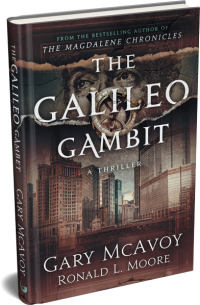
GENERAL: Edicola is a news kiosk. Edicola Sacra is located on Rome’s Piazza del Risorgimento near the Vatican.
PROLOGUE: While the conversational elements are obviously contrived, Galileo’s recitation of his experience is essentially accurate. We used the following references to guide the narrative:
- Galileo’s Mistake: A New Look at the Epic Confrontation Between Galileo and the Church, Wade Roland, Arcade Publishing, New York, 2012.
- Behind the Scenes at Galileo’s Trial, Richard Blackwell, University of Notre Dame Press, Notre Dame, 2006.
- The Galileo Affair: A Documentary History, Maurice A. Finocchairo, University of California Press, Berkeley, 1989.
- Retrying Galileo 1633 – 1992, Maurice A. Finocchairo, University of California Press, Berkeley, 2005.
- The Trial of Galileo: Essential Documents, Maurice A. Finocchario, Hacket Publishing, Indianapolis, 2014.
In addition, we consulted online resources extensively.
CHAPTER 2: Historically, we couldn’t find any record of Galileo giving Pope Urban VIII a telescope. But it seemed reasonable that he could have.
CHAPTER 3: The document archives of the Dicastery for the Doctrine of the Faith were invented for the book. They may or may not actually have their own records archives.
CHAPTER 6: This story takes place largely in Chicago. While some of the business names have been changed, the places where they are located actually exist. Ron spends about three weeks a year in Chicago, and described many of the locations from memory, with a little help from Google Earth.
CHAPTER 14: You can triangulate a cell phone’s location from the cell towers it pings and the signal strength. As far as we have read, the cellular companies keep this information for some period of time.
CHAPTER 15: The bug detection routine is rudimentary, but reasonably accurate, at least as far as we were able to do with internet research. I’m sure there are more sophisticated devices both for listening and for detection.
CHAPTER 21: Just a quick note about the courtroom procedures. The “Retrial” is an educational exercise and not bound by any formal or official rules other than as agreed to by the parties and the host organization, so it gave us a lot of freedom in crafting the courtroom scenes. Astute legal observers may notice inconsistencies between the procedures invented for this exercise and the real procedures for any particular jurisdiction. That said, they aren’t that far off either. We let the dean exercise her assumed authority as a judge might, and the parties accepted it as would be expected in such an educational exercise.
CHAPTER 23: The important part of this exchange was:
“Matthew 25:21” (Well Done, Good and Faithful servant).
A few moments later, a reply came back.
“Exodus 22:18.” (Suffer not a witch to live).
The man texted back. “Matthew 6:10.” (Your will be done).
(This is Cardinal Caputo and Bishop Sharma deciding to have Kat taken out.)
CHAPTER 33: Both the yawara stick and the coin purse sap exist. Yawara is used in a variety of Jujitsu styles and other martial arts.
CHAPTER 35: While the Injunction of 1616, if it existed, is probably lost to history, the Confession of Galileo in 1633 still exists and is accurately represented (in the part that was included) in the text. The complete confession is available online.

PROLOGUE: Owing to the fact that there are no contemporaneous accounts of Pope Joan during her lifetime—and the only known accounts of her emerged some four centuries later—much of what we know about Joan Anglicus, if she did in fact exist at all, is presumed, and what appears here was extracted from the few resources available on her. Keep in mind, too, that the Church was the custodian of most knowledge then, and most certainly all books, and thus controlled how history was recorded and what records were kept. A female pope would have not been something the early Church would have heralded, much less acknowledged.
The earliest known written account of Pope Joan was made by a Dominican friar named Jean de Mailly in the thirteenth century. He included the story in his “Chronicle of Metz,” which was a compilation of historical events and legends. Other medieval chroniclers, such as Martin of Opava and Vincent of Beauvais, also wrote about Pope Joan in their works. However, it is unclear if these accounts are based on any historical facts, if they were passed down through oral legends, or if they are purely fictional.
Too, Pope Joan—or at least a female papal image—has figured prominently in tapestries and tarot cards since the early Middle Ages.
CHAPTER 1: The Codex Anglicus is a product of my own imagination, but it worked out ideally for the story. However, the Codex Vaticanus does exist‚ and its descriptions as discussed are all factually supported.
CHAPTER 3: Old English—or what was known as the Anglo-Saxon language during the Middle Ages—was the lingua franca of the era and has been translated as best as possible here.
CHAPTER 5: The Lady Chapel of Sherborne Abbey does in fact have four stones engraved with the virtues of the Virgin Mary. As far as I know, they do not recede with pressure, as I’ve added that bit of magic along with the secret compartment beneath Lady Margaret’s tomb.
CHAPTER 7: The papal monogram coinage shown here is a genuine artifact and could possibly be the actual coin issued for the reign of Pope Joan (as Pope John VIII) were she to be found as legitimate.
CHAPTER 8: Here I have stuck as close to documented history as possible, weaving the fabric of Pope Joan’s life with actual people, places and events of the ninth century. Her son Gregory—whom I have named here fictionally—becomes the Bishop of Ostia at the same time a real Gregory became Ostia’s bishop. This real bishop was named by the real Pope John VIII who served the Church at this time. I have established that Joan’s lover, Cardinal Alexander Rossini (another real person), honored his paramour by taking her own regnal name when he rose to become Pope John VIII. The names and timing were simply too compelling for me to ignore, further blurring the lines between fact and fiction.
And in fact, Pope John VIII is rumored to have been poisoned and then clubbed to death in the ninth century. He served as pope from December 14, 872, to December 16, 882. However, historical evidence on the circumstances of his death is not clear, and the accounts of him being poisoned and subsequently beaten to death remain unverified. The details of Pope John VIII’s death have been the subject of speculation and sensationalized stories throughout history.
CHAPTER 15: It is unknown whether or not the Vatican possesses a Shard of the True Cross or a Thorn from Christ’s Crown of Thorns. Many churches and religious institutions around the world claim to have fragments of the True Cross or the Crown of Thorns. These relics have been venerated by the faithful, and often they’ve been passed down through the centuries. However, their authenticity is difficult, if not impossible, to verify.
One notable example is the Crown of Thorns at the Notre-Dame Cathedral in Paris. It is considered the cathedral’s most precious and revered relic. It was originally held at the Basilique Sainte-Chapelle in Paris, which was built specifically to house it, before it was moved to Notre-Dame in the eighteenth century.
Moreover, prior to the Seventh Crusade, Louis IX of France bought from Baldwin II of Constantinople what was venerated as Jesus’ Crown of Thorns. It is kept in Paris to this day, in the Louvre Museum.
Relics that are purported to be from the True Cross are found in many places. The Church of the Holy Sepulchre in Jerusalem and the Basilica di Santa Croce in Gerusalemme in Rome are two places that claim to possess fragments.
In any case, it’s always good to remember that the importance of these relics comes primarily from the faith of the believers who venerate them, rather than their historical authenticity.
CHAPTER 33: In the pope’s signature, the customary “PP” is an abbreviation for “Papa Pontifex,” which is Latin for “Pope” and “Pontiff,” respectively. Therefore, when a pope appends “PP” to their name, it serves as a formal title and a reinforcement of their role as both the Bishop of Rome and the head of the Catholic Church.
CHAPTER 34: There is actually a most unusual “Pope’s Chair” from the Middle Ages—whose origin and purpose is murky, if not unknown—as pictured in this chapter.
Its official name is “Sedia Stercoraria” and legend has it that—in order to prevent another female pope from sneaking in—the newly elected pontiff had to sit on it while a deacon put his hand under the chair and verified that the new pope had masculine attributes. Once the sex of the subject was confirmed, the deacon proclaimed: “Duos habet et bene pendentes,” Latin for “He has two and they dangle nicely.”
Though there is some controversy about the chair’s origin, most scholars—the same ones who deny there ever was a Pope Joan—eschew the chair’s legend. See more at Wikipedia.

PROLOGUE: Although, to the best of my knowledge, Leonardo did not invent a Celestial Guardian, the two events mentioned—the conjunction of Mars, Saturn, and Venus in 1504 and the appearance of the Comet C/1506 Y1—were both actual events during his lifetime.
The concept of asteroids as we understand it today didn’t exist during the time Leonardo lived (1452-1519). The scientific understanding of the solar system was vastly different during the Renaissance. The first asteroid, Ceres, wasn’t discovered until 1801, nearly three centuries after da Vinci’s death. Thus, while da Vinci was a man far ahead of his time in many respects, it’s unlikely that he would have understood or predicted the impact of an asteroid in the way that we understand it today. However, he could have theoretically observed and recorded unusual celestial events and their potential terrestrial impacts, as was common with other scholars of the period.
CHAPTER 5: In 1809, shortly after annexing the Papal States as the property of France and arresting Pope Pius VII, Napoleon claimed title to the Vatican Archives and directed that they be shipped to Paris, where it seemed only natural that the world’s greatest library and art collections should reside. Officials of the French National Archives were thus dispatched to Rome, where they packed up everything they could find into some three thousand cases, which were then escorted back to Paris in hundreds of fortified wagons drawn by teams of oxen and mules.
Following Napoleon’s abdication in 1814, a decree was issued for the repatriation of all books, parchments, and other treasures taken from Rome. But it soon became evident that in the interim much of the collection had been pilfered or was otherwise unaccounted for. Indeed, of the three thousand cases originally seized from the Vatican alone, no more than seven hundred found their way back to Italy. It was later learned that one of the obstacles in effecting restitution was the vast expense necessary to pack and transport the shipments. And in one of history’s most lamentable decisions, papal commissioners—conveniently influenced heavily by the chief French archivist—judged that great masses of documents were of insufficient interest or value to warrant the expense of their return all the way back to Rome, and so they were either retained by the French Library, or sold off by weight for use in making cardboard and as wrapping paper for fish and meats in the butcher shops of Paris.
CHAPTER 7: In the event of such a devastating threat as an asteroid impacting Earth, as described, the catastrophic fallout revealed here is realistic, based on information taken from official sources whose job it is to plan for such things. Just think of the cataclysmic Chicxulub impactor on the Yucatan peninsula sixty-six million years ago, the one that killed off the dinosaurs and other mass extinctions. Estimates of that asteroid’s size vary, but it is generally thought to have been about ten to fifteen kilometers (six to nine miles) in diameter.
CHAPTER 23: The honor of naming asteroids falls primarily to the discoverers of these celestial objects. The process is overseen by the International Astronomical Union (IAU), which is the global authority for naming celestial bodies and their surface features.
Here is an overview of how the process typically works:
1. **Discovery and Provisional Naming**: When an asteroid is first discovered, it is given a provisional name by the discoverer. This provisional name usually includes the year of discovery and an alphanumeric code indicating the order of discovery within that year.
2. **Observation Period**: After its initial discovery, the asteroid is observed for several years to precisely determine its orbit. This is crucial because the IAU requires a confirmed, stable orbit before an official name can be assigned.
3. **Suggestion of a Name**: Once the asteroid’s orbit is confirmed, the discoverer has the privilege to suggest a name for the asteroid. This name could be inspired by mythology, history, cultural figures, or even personal names, subject to certain rules and conventions set by the IAU.
4. **IAU’s Approval**: The suggested name is then submitted to the IAU, specifically to its Small Bodies Nomenclature (CSBN) committee. The CSBN reviews the proposal to ensure it adheres to the IAU’s naming conventions. These conventions include guidelines like avoiding offensive names, overly commercial names, or names too similar to existing celestial bodies.
5. **Official Naming and Publication**: Once the CSBN approves the name, it becomes the asteroid’s official designation. The name is then published in the Minor Planet Circulars, making it internationally recognized.
It’s worth noting that while the right to name an asteroid is traditionally given to its discoverer, in some cases, the discoverer may involve the public or specific communities in the naming process, especially in the case of particularly significant or interesting discoveries. However, the final submission and approval always go through the IAU’s established process.
CHAPTER 30: Alas, the Vatican’s “Peter’s Eye” satellite is the product of “Gary’s Imagination.“ To the best of my knowledge, the Church doesn’t have its own satellite. Yet. If they did, I do think Oculus Petri would be a fitting name for it.
The Vatican does have access to satellite services through agreements with other countries or commercial providers for telecommunications, broadcasting, and other purposes. The Vatican’s radio station, Vatican Radio, uses satellite technology to broadcast its programming around the world, as one example.
EPILOGUE: Novaya Zemlya, a Russian archipelago in the Arctic Ocean, was used by the USSR in the 1960s for nuclear testing, including detonation of the most powerful nuclear weapon ever tested, known as Tsar Bomba during the Soviet Union era.

PROLOGUE: Every word of the Prologue is true, based on historical references, biblical passages, and oral traditions.
CHAPTERS 10+15: St. Linus was, in fact, the successor to St. Peter, traditionally the first two popes of the Roman Catholic Church (long before the Church was officially organized). There is no argument as to who was first and who was second; the “equal” standing created here is fictional.
CHAPTER 46: Finally, at long last, Michael and Hana consummated their relationship, taking it to the next level. I really struggled with this chapter. The choice to have Michael and Hana make love in the Secret Archives is deeply symbolic and emotionally charged, reflecting the culmination of years of suppressed longing, unspoken connection, and mutual respect. The setting—steeped in history and secrecy—mirrors the intimacy and vulnerability of their act, a moment where duty and discipline give way to raw, undeniable human emotion. Yes, it was impulsive and bypassed traditional courtship, but the intensity of their shared experiences and the trust they’ve built over time made this moment feel both inevitable and natural. It is less about sin or convention and more about two people finally surrendering to the depth of their bond, a collision of passion and timing that defies easy categorization or judgment.
EPILOGUE: Logically, Michael wrestles with whether or not he should remain in the priesthood. Frankly, I haven’t made a decision on this one way or another going forward, though I believe I’ve made a strong case for him leaving. On the other hand, remaining in the priesthood will present challenges that are too attractive for a writer to ignore. So this is just a heads-up to stay tuned…
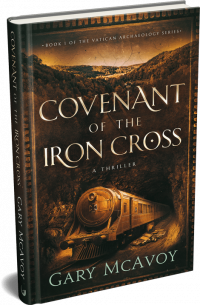
PROLOGUE: The Nazi Gold Train is one of the most enduring legends of World War II, a tale of a train laden with gold, priceless artworks, and other treasures looted by the Nazis as they retreated in the war’s final days. Allegedly hidden in a secret tunnel system in the Owl Mountains of Poland, the train has never been conclusively found, despite numerous expeditions and ground-penetrating radar surveys in recent years. The story gained renewed attention in 2015 when treasure hunters claimed to have located a train near Wałbrzych, though no evidence was ultimately recovered. While skeptics argue that the train is a myth, created from wartime chaos and post-war folklore, believers contend that its disappearance was part of the Nazis’ deliberate efforts to hide their plunder for a potential resurgence. The train’s existence remains unproven, but its legend persists, captivating archaeologists, treasure hunters, and historians alike as a tantalizing mystery waiting to be solved.
CHAPTER 2: The Nazis, particularly under Heinrich Himmler and the SS, displayed an avid interest in the Knights Templar, though this interest was part of a broader fascination with medieval and mystical orders. Their focus on the Templars was intertwined with their ideology, myth-making, and quest for legitimizing their vision of Aryan supremacy and a new Germanic empire.
CHAPTER 5 and elsewhere: The Nazis, particularly through Heinrich Himmler and the SS, had a keen interest in Norse runes and the supernatural as part of their effort to construct an ideological foundation rooted in Aryan mysticism and Germanic pagan traditions. They appropriated ancient symbols like the runic alphabet, especially the Sieg (victory) rune, used in the SS logo, to evoke a connection to an idealized, warrior-centric past. This fascination extended to occult practices, esoteric rituals, and pseudo-scientific theories, often blending mythology with fabricated history to support their racial ideology and reinforce the mystique of the Third Reich as a modern reincarnation of ancient Germanic greatness.
CHAPTER 18: Though the technology did not exist during the time of the Nazis, volcanic thermal energy is now used to generate electricity, but it is more commonly referred to as geothermal energy when harnessed for human use. Geothermal energy relies on heat from the Earth’s interior, which can be especially accessible near volcanic regions. And, in fact, Iceland is a global leader in geothermal energy, deriving about 25% of its electricity from geothermal power. Its location on the Mid-Atlantic Ridge, with high volcanic activity, makes it ideal for this purpose.
Projekt Riese (“Giant”) was a massive and secretive Nazi construction project during World War II in the Owl Mountains of modern-day Poland. Initiated in 1943, the project involved building an extensive underground complex of tunnels, bunkers, and chambers, potentially intended as a bomb-proof military headquarters for Hitler, advanced weapons research facilities, or storage for looted treasures. Constructed by the Organisation Todt using forced labor, including concentration camp prisoners, the project caused significant loss of life due to brutal working conditions. Although several sites, such as Osówka and Włodarz, were partially completed, the project was abandoned as the war ended in 1945. Today, these tunnels remain subjects of speculation and intrigue, particularly regarding their purpose and rumors of hidden Nazi treasures.
Keeping in mind that the legendary Gold Train has yet to be discovered, the contents described in the cars are obviously fictive, as is the Nazis’ assumed use of volcanic thermal energy to power the mountain systems. But I had to keep the lights on somehow, didn’t I?
As I mentioned earlier, “Projekt Vulkan”—the use of geothermal energy during the 1940s—was purely fictional.
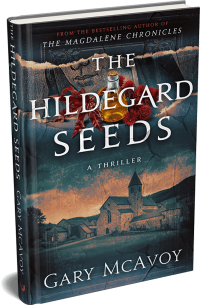
FIRST, A WORD ABOUT MY INSPIRATION: As I close the pages of this book, I want to take a moment to honor a historical figure who has profoundly inspired me during its creation: Hildegard von Bingen.
As I mentioned in the Prologue, Hildegard, born in 1098, was a Benedictine abbess, writer, composer, philosopher, mystic, and visionary. Her extraordinary contributions spanned the realms of theology, medicine, music, and natural science—fields often inaccessible to women of her time. She fearlessly navigated a patriarchal society, asserting her voice and intellect to become one of the most influential figures of the medieval era. Her writings, particularly those on natural medicine and holistic healing, remain relevant even in today’s world.
What has captivated me most about Hildegard is not just the breadth of her achievements but the spirit of her work. She embodied the belief that faith and knowledge are not opposing forces but complementary paths to understanding the world. Her insistence on ethical responsibility in the pursuit of knowledge and her commitment to using her gifts for the betterment of humanity resonate deeply with the themes explored in this story.
As I researched Hildegard’s life and works, I was struck by her courage and conviction. She spoke truth to power, often challenging ecclesiastical authorities and societal norms when she believed justice was at stake. She reminds us that the fight for truth and integrity is not bound by time and that the preservation of knowledge is a sacred duty.
While writing this book, I frequently listened to her hymnal music, letting her ethereal melodies fill my workspace. Her compositions—soaring and transcendent—transported me to a place of quiet contemplation, as if her spirit were present, guiding the words on the page. It was in these moments of inspiration that I felt a deeper connection to her, as though her timeless wisdom and creativity were woven into the story itself. Even today, her music can be found on most streaming services.
Through this book, I hope to shine a light on the enduring relevance of her teachings and to honor her legacy. Hildegard von Bingen was more than a product of her time—she was a visionary whose influence transcends centuries, reminding us of the power of wisdom, resilience, and faith, and whose light continues to guide, inspire, and challenge us to be better stewards of truth and knowledge.
PROLOGUE: While the names of Hildegard’s parents are correct historically, they were not connected to the Saint-Clair family at all, which I’ve used here for creative purposes in the story. Hildegard did originate from a noble lineage, yet the surname of her family seldom appears or is acknowledged in historical records. During the medieval period, particularly throughout the 11th and 12th centuries, the concept of surnames as understood in contemporary times was neither prevalent nor formalized, especially among noble circles. People were typically distinguished by their geographical origins, titles, or familial connections rather than by surnames. So in Hildegard’s case, “Hildegard von Bingen” literally means Hildegard “of Bingen” (from the small town of Bingen, Germany).
The humoral theory of medicine, which was the dominant medical paradigm in Europe until the late 17th century, believed that diseases were caused by imbalances among the four “humors”: blood, phlegm, yellow bile, and black bile. Cancer was often attributed to an overproduction or malfunction of black bile. According to this theory, each humor was associated with specific qualities (hot, cold, moist, and dry) and parts of the body, influencing both physical and psychological characteristics.
Hildegard’s Lingua Ignota (“Unknown Language”) is a constructed language she created, consisting of approximately 1,000 unique words. It is paired with an invented script and was likely intended for spiritual expression or as a mystical, symbolic code. The vocabulary draws heavily on Latin and German roots, featuring terms for celestial beings, flora, fauna, and human roles. While its exact purpose remains debated, scholars believe it reflected Hildegard’s vision of a divine, universal tongue that transcended earthly languages, underscoring her creativity and deep theological insights.
Lastly, to avoid confusion with botanical realities, I contrived the plant name Ricinus aureum (“Golden Castor”), which doesn’t exist. Too bad, isn’t it…?
CHAPTER 6: Rupertsberg Monastery (which I have redesignated as an “Abbey” in the book), was originally founded by Hildegard von Bingen in the 12th century, but is no longer functional as a monastery and exists only in ruins. The monastery was located at the confluence of the Nahe and Rhine rivers near Bingen am Rhein, Germany.
Hildegard established the monastery around 1150 after leaving the Disibodenberg Monastery, which included a Frauenklause, a female hermitage associated with the monastery. Rupertsberg became a center for her theological work, music composition, and herbal medicine. The monastery was destroyed during the Thirty Years’ War (1618–1648), and its ruins were further dismantled over time. Only fragments of the original structure remain today. Some archaeological efforts have preserved these remnants, but the site is not a functioning religious institution.
After founding her first monastery at Rupertsberg, Hildegard sought to expand her work. When a nearby Benedictine monastery in Eibingen fell into neglect, Hildegard acquired the property in 1165 and reestablished it as a vibrant religious community. The Eibingen Abbey became a place for women devoted to the spiritual practices and teachings inspired by Hildegard’s visionary theology, music, and holistic approach to healing. Today, it is known as Abtei St. Hildegard, and continues to honor her legacy as an active Benedictine community.
CHAPTER 11: Plant galls are fascinating natural formations that occur when plants respond to the presence of foreign organisms, such as insects, mites, fungi, bacteria, or even other plants. These abnormal growths can appear on leaves, stems, roots, or flowers and often serve as protective homes or nutrient sources for the organisms that induce them. Despite their often unusual appearance, galls showcase the remarkable adaptability and complexity of plant biology.
Throughout history, plant galls have held a place of wonder and utility in various cultures. Ancient herbalists and healers recognized their medicinal potential, using galls for a wide range of treatments. Oak galls, for instance, were highly valued for their high tannin content, which made them effective astringents. They were used to treat wounds, reduce inflammation, and combat infections.
Beyond medicine, plant galls have played a significant role in other industries. The tannins extracted from oak galls were essential in the production of iron gall ink, a key writing material used from the Middle Ages through the 19th century. This durable, dark ink was used to pen some of the most important documents in history, from illuminated manuscripts to early scientific treatises.
Galls have also been utilized as natural dyes, producing rich hues of brown and yellow, and as components in traditional cosmetics and beauty treatments. Their unique chemical compositions continue to intrigue scientists, who study them for potential applications in pharmaceuticals and sustainable materials.
These unassuming botanical marvels remind us of nature’s ingenuity, providing not only shelter and sustenance to their inhabitants but also a wealth of resources for humanity across the ages. Plant galls, in their quiet complexity, reveal the profound interconnectedness of life.
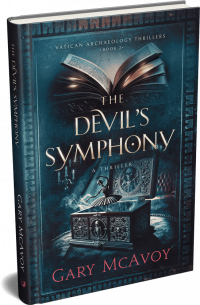
PROLOGUE: Vincent Malvagio is fictitious. His personality and interest in the effects of sound reflect an interest in a century where many prodigious and productive composers (Mozart, Beethoven, Bach, and many others) filled European concert halls and cathedrals with their music, affecting audiences both then and now.
CHAPTER 7: Franz Mesmer (1734–1815) began his studies at the Jesuit-run University of Dillingen in 1754. He became deeply intrigued by the idea that external forces could influence the body’s internal “misbehaving fluids”—a concept rooted in the prevailing medical theories of his time. This fascination led him to develop a therapeutic method he called animal magnetism, which he believed could realign the body’s energies to restore health. Initially, he used magnets to channel this force, but later relied on the movement of his hands, intense eye contact, and even the ethereal tones of the glass harmonica to induce healing. His techniques gave rise to the term “mesmerizing,” and he is often credited as a forerunner of modern hypnotism. Though celebrated by some as an innovator, Mesmer’s work was also the subject of intense skepticism and criticism during his lifetime.
Cardinal Antonio Bellari is a fictional character.
CHAPTER 8: Benjamin Franklin did, in fact, invent the glass armonica in 1761—a remarkable instrument born of his fascination with music and science. Inspired by the popular parlor trick of rubbing the rims of water-filled wine glasses to produce musical tones, Franklin reimagined the concept into a more elegant and playable form. He mounted a series of glass bowls, graduated in size and nested along a horizontal spindle, which could be spun by a foot pedal. As the performer touched the spinning glasses with moistened fingers, the armonica emitted haunting, ethereal tones unlike anything previously heard. It quickly gained popularity among composers and audiences alike, praised not only for its novelty but for the otherworldly quality of its sound. Even Mozart and Beethoven composed for it. Though its popularity waned by the 19th century, the glass armonica remains one of Franklin’s most curious and enchanting inventions—equal parts entertainment and alchemy.
CHAPTER 13: Santa Lucia Monastery is an architectural complex in the town of Adrano, in the Province of Catania, in the region of Sicily, Italy. The former Benedictine monastery currently serves as an elementary school, alongside the Giovanni Verga High School.
CHAPTER 16: San Lorenzo Monastery is fictional, although San Lorenzo is a large district outside of Rome.
CHAPTER 24: The Black Hymnal is fictional.
CHAPTERS 26 and 27: The Red Messiah Church, perched high in the remote Austrian Alps, was constructed in the mid-eighteenth century during a period of intense religious revival across Central Europe. Commissioned by a breakaway sect of millenarian monks, the church was named in honor of a prophesied redeemer figure—the Red Messiah—believed by its founders to herald the end of days through blood and revelation. Built of crimson-hued stone quarried from the surrounding mountains, the church stood as both sanctuary and warning, its frescoes depicting apocalyptic visions and veiled saints whose eyes seemed to follow the penitent.
For generations, it drew the devout, the desperate, and the dangerously obsessed. But as its teachings drifted further from orthodoxy and local rumors of occult rites spread, the church fell under suspicion. Eventually, during the late nineteenth century, it was abandoned—left to crumble beneath snow and silence.
This long-forgotten mountaintop sanctuary became the historical basis for the fictional Red Messiah Monastery featured in these chapters, reimagined as a hidden refuge cloaked in ancient heresies and prophetic mystery.
CHAPTER 35: The Prague Codex is fictional.
CHAPTER 36: Charles University was founded in Prague in 1348 by the Holy Roman Emperor Charles IV. At the time, it was the only institution of higher education in Europe north of the Alps and east of France. Today, it is known as one of the world’s oldest universities and is still active.
CHAPTER 43: There are several small villages nestled in the Swiss Alps. My fictional village of Murcote is a fusion of Murren (population 450) and Morcote (population 750), two picturesque, but challenging to travel to, villages high in the Alps.



